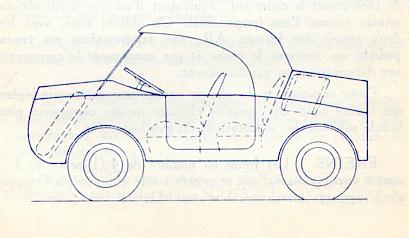Georges IRAT : "La Voiture du Bled" for North Africa
- COCKPIT
- Dec 29, 2021
- 4 min read
At the end of hostilities in 1945, France found itself helpless in all areas, particularly in that of transport; cars and trucks from French brands are rare. The American forces left thousands of vehicles in place which made up for this shortage and which would serve for a long time in the ranks of the French army.
At the 1947 Motor Show, the public discovered a small machine, presented by the Compagnie des Moteurs DOMMARTIN. Capable of driving on all types of roads or paths, it is powered by a flat 804cm3 twin-cylinder engine from a Gnôme & Rhone motorcycle which is fitted to the AX2 military motorcycles. It is capable of traveling at 80 km / h, climbing a slope of 35% and crossing a ford of 50cm. A very small series will be built before the abandonment of the project.

Georges IRAT, very well known before for his racing cars, found himself at the end of the 1940s in a difficult financial situation. Like many small French automobile companies, it is penalized by the PONS plan, which streamlines construction, aimed at limiting the number of cars authorized to be built. It still presents a few prototypes of sports vehicles, without success. Georges IRAT then decides to change course, finish the racing cars, make way for all-terrain vehicles with a military vocation. IRAT has, since 1949, settled in Morocco, in Casablanca, for financial reasons. His new company took the name of Société Chérifienne d'Etudes des Automobiles GEORGES IRAT. He surrounded himself with the engineer Emile PETIT who drew the plans for the future small car, very similar to Dommartin's prototype.

The small car, convertible with 3 seats, is born. It takes the name of "Bled car", type A. 3.20m long, 1.90m wide, it includes a folding windshield and it is installed at the rear, a 610 cm³ engine of 28hp which equips the Panhard Dyna. The interior layout is original, with a central steering wheel, three seats arranged in a cloverleaf, including two in the rear. Its gearbox is three-speed for the road to which is added a reduction gear which allows in any terrain, to have three additional speeds. Only the rear wheels are driving.Coté performances, la voiture roule à 80 km/h sur route, peut franchir des gués de 50cm et gravir une pente de 40 %. A son réservoir à carburant principal, on peut lui adjoindre une extension pour deux jerricans fixée sur une remorque lui conférent une autonomie d’environ 1500 km.
The tests took place discreetly on Moroccan tracks and at the 1950 Motor Show at the Grand Palais, Georges IRAT exhibited two prototypes. One of them will be on display with a trailer. From then on, the vehicle began its tests at the Satory camps and then presented to the public in Montlhery in 1951.

With the support of Marshal JUIN, Georges IRAT places an order for around thirty 610 cc and 3 750 engines from the Panhard company. In 1951, again at the Salon de l'Automobile, there was a new exhibition with a new coupling that exactly followed the tracks of the vehicle's wheels. The new prototype has undergone some transformations, in particular at the level of the doors which are replaced by notches as on the Jeep. Unfortunately, the disappointment was great, the company did not win an order and IRAT then decided to abandon the "bled car" project and returned to France. He will create a new company, the SEAVB (Société d'Etudes Automobiles pour la Automobile du Bled), which is based in Paris.
A new prototype, called "type B" was presented again on the IRAT stand at the Grand Palais in 1953. Modified with a more attractive line, the new model was fitted with a 750cc Panhard engine. The rest of the vehicle does not change war, still three seats and only the rear wheels are driving.
At the same time as the model B, IRAT will study an amphibious model. The Type C. The latter vehicle is of interest to two companies who see a possibility to equip airborne troops with it. These are the companies SAGA (Société Anonyme de Gérance et d 'Armament) and the aircraft manufacturer SCAN. At least 32 copies had to be built, the only existing model bearing this serial number. Finally, another version of the type C will be manufactured and studied by the AMX workshops. It is an amphibious, 4-seater vehicle that is very manoeuvrable and stable in an aquatic environment. This model will be approved by the Mining Services in November 1954.



Despite the manufacturer's hope of making a dozen vehicles, the town car cannot compete with the famous and proven Jeep Willys (which is manufactured under license by Hotchkiss), handicapped by its lack of front drive wheels while its competitor can easily switch from 4x2 mode to 4x4 ...
Only two copies are currently known. Found in the stocks of the Saumur tank museum, they have been restored and are now on display in the "curiosities" room.
The specifications of La voiture du Bled





























